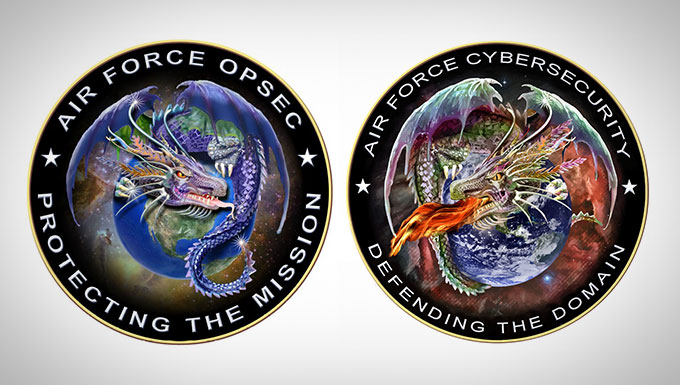Air Force Office of Information Dominance and Chief
Information Officer / Published August 20, 2015
WASHINGTON (AFNS) -- Lt. Gen. Bill Bender, the Air Force
chief information officer, and Maj. Gen. Martin Whelan, the Air Force director
of future operations, have partnered to increase awareness of the importance of
operations security and cybersecurity to protect the Air Force mission,
personnel and their families.
“We are thrilled with this new partnership,” Whelan said.
“Cybersecurity is such an integral part to ensuring operations security in our
Air Force. We want our Air Force personnel to understand that cybersecurity is
everyone’s responsibility and that their daily actions can make or break a
mission and/or put themselves and their families at risk.”
Bender agreed. “We are hoping that by pairing our OPSEC and
new cybersecurity logos together it will remind personnel of the relationship
that OPSEC and cybersecurity share in keeping our personnel and our mission
safe.”
OPSEC has always been an important factor in the military.
The official OPSEC program launched during Vietnam in 1966 with Operation
Purple Dragon. “Purple Dragon” was the unclassified nickname, given by the
Joint Chiefs of Staff, for a study done on the loss of B-52 Stratofortresses in
Southeast Asia. National leadership became concerned that there was a security
breach since U.S. B-52 bombers were being shot down at a very high rate. It was
apparent that the North Vietnamese had been gaining prior knowledge of bombing
mission times and locations. Thus, Operation Purple Dragon was born and it was
soon discovered that existing procedures allowed flight plans to be received
directly by Hanoi.
OPSEC has since become an established process used by
military, federal, state and local agencies, as well as private companies. Each
year, additional businesses realize the importance of OPSEC in their day-to-day
operations to help protect proprietary and sensitive information from
disclosure, espionage and exploitation. Even at home, OPSEC can help protect a
person’s identity, family and home from those who strive to exploit their
information for personal gain.
In today’s world, modern technology instantly enables any
individual to share information around the globe. Though people may
intentionally share this information with relatives and business partners they
could also be unintentionally providing access of this same information to
terrorist and criminal organizations. Cybersecurity and OPSEC can help protect
personal and critical information. As threats around the world continue to
grow, OPSEC will always be there to protect a precious commodity: information.
Today, the OPSEC (Purple) Dragon symbolizes the importance
of protecting critical information and observable actions about mission
capabilities, limitations and intentions in order to prevent or control
exploitation by an adversary. The new Cybersecurity Dragon falls in the same
family by symbolizing the importance of cybersecurity to protect and secure our
personnel and their mission allowing the Air Force to fly, fight and win in a
cyber-contested environment.
The OPSEC Dragon has done a superb job reminding Air Force
personnel of the importance of operations security for decades. When partnered
with the new Air Force Cybersecurity Dragon, the two act as a powerful reminder
to help protect Air Force personnel, their missions and their families.
“Virtually every mission across the range of military operations
depends on cybersecurity and every Airman has an important role to play with
respect to OPSEC and cybersecurity,” Bender said. “We are much more effective
when everyone plays their part.”








No comments:
Post a Comment